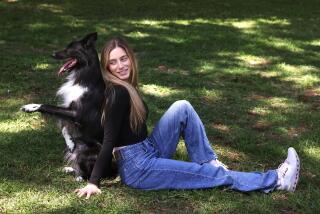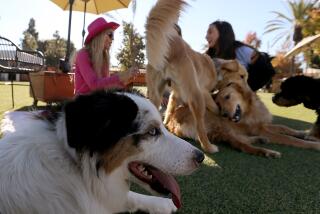Sometimes, It Takes Terrier to Tango
- Share via
POINT OF ROCKS, Md — Suzannah Skalsky’s eyelids are dusted with glitter, and her hairdo is sprayed firmly in place. The cowgirl-style fringe on her hot-pink shirt matches the trim around the neck of her dance partner, who sits patiently beside her while 13-year-old Suzannah nervously waits for the judges to call them to the floor.
Suzannah rolls her eyes as her mother snaps yet another picture. The accomplished pair have traveled from Troy, Mich., for this competition, and their moment is drawing near. But when they’re finally on the dance floor, nothing goes as planned. Suzannah’s partner, Missy, is distracted. She stops for a scratch, then looks around the room with casual interest. She can’t seem to focus on the routine. But then, terriers aren’t particularly known for their dance skills.
Missy is a terrier mix rescued from the dog pound. On this day in late November, she is acting as if she could be anywhere, anywhere except the North American Nationals competition of the World Canine Freestyle Organization.
Sympathetic applause from the audience distracts her even further. By the time the twangy country music stops and Missy is ordered back to her crate, Suzannah is in tears. This is the high-stakes world of competitive dog dancing, and it will break your heart.
A little bit “Flashdance,” a little bit “Best in Show,” dog dancing is a sport in its infancy. But Patie Ventre, founder of the organization, has big dreams. “I’d like to see it in the Olympics in 10 years,” said Ventre, a petite, chain-smoking former figure skater from Brooklyn who is the sport’s most avid promoter.
Canine freestyle has its roots in dog obedience competitions and demonstrations, in which routines were sometimes performed to music. Dog dancing split off on its own in the late 1980s in Canada, Great Britain and the United States.
Today there are two competing nonprofit organizations in the U.S: the World Canine Freestyle Organization, which Ventre founded in 1999, and the Canine Freestyle Federation, an organization founded in 1995 that is based in Fairfax, Va. Ventre estimates there are about 800 competitors worldwide.
“Sometimes in life you’re very lucky that all the things you cherish come together in one thing. That’s what happened to me with canine freestyle,” Ventre said.
A former advertising executive, she was the publicity director for dog obedience and agility competitions that were sponsored by Quaker Oats. Dancing dogs started as a publicity ploy and grew into a passion, Ventre said.
But when Quaker Oats sold its pet food line to Heinz, the company pulled the plug on her funding and she struck out on her own. Now she has her own dog, Dancer, and the two are fierce competitors. They took first prize at the nationals in Maryland late last year.
There are trophies for first-place winners and ribbons for second- and third-place teams. For each event, special awards also go to the competitors with the highest artistic score and the highest technical score.
*
At the nationals, the 60 routines ranged from a football-themed rock ‘n’ roll number--which had a golden retriever named Ashley doing push-ups along with her partner--to a provocative dance set to “The Stripper,” music more commonly heard at bachelor parties than kennel clubs.
For the latter performance, Cindy Pfister of Altoona, Pa., wore a shimmering blue bodysuit and shared a white feather boa with her miniature pinscher, Sammie. When the routine was finished, Pfister downed a sports drink, and Sammie took a nap.
California is behind the curve when it comes to dog dancing. Only a few obedience schools around the state have classes, and there’s only one in Southern California. The first competition in the state is scheduled for August, when the World Canine Freestyle Organization plans to hold the “I Left My Paws in San Francisco” event in the Bay Area.
But enthusiasts insist that dog dancing is for the masses. Unlike the hoity-toity world of dog shows, which require pedigrees and follow rigid protocols, anybody with a groove going can ask a dog to dance.
Contests are open to any breed and any age dog. People and their pooches just get out there and dance to the music, competing against others at similar skill levels. Points are given for keeping time to the music, for maintaining no more than a few feet of distance from a partner, for intricacy of moves and the level of attention, animation and attitude displayed by both humans and canines.
The biggest hurdle to dog dancing, suggest many who have tried it, lies in finding music your dog will respond to.
“If I put on a song she doesn’t like, she just barks,” said Theresa Zuzworsky of Germantown, Md., whose glossy 8-year-old Irish setter, Caitlin, finally found a composition to suit her in Bette Midler’s rendition of “Everything’s Coming Up Roses.”
For spectators, the hardest part can be discerning between a dog that is dancing and a dog that is just freaking out because his master is jumping around in a tutu. Some common moves, depending on the size of the dog, can include the dog weaving in and out of its partner’s legs, running backward and jumping into its partner’s arms on cue. The human half of the team tends to be more involved in costumes, although dogs are also permitted to wear flashy collars or other unobtrusive accessories to set the proper mood.
*
Southern California has been exposed to dog dancing in fits and starts: just a demonstration now and then at a dog show or a kennel club, according to Sue Nelson, who teaches dog dancing classes at Jump Start Dog Sports obedience school in Yorba Linda.
“Most of the people that sign up for these classes are people who want to do things with their dogs, but they don’t want the competition,” Nelson said. “It’s strictly for fun, and the dogs love it.”
That’s just what Beverly Blanchard thought the first time she tried it. Now she’s an avid competitor. “Most of us get into it the same way,” she said of the pastime that has captured her heart. “They swear they’re never going to get up in front of a bunch of people and dance with their dogs. It sounds crazy. Then you see it and maybe you get a little teary-eyed, so you try it, and your dog enjoys it so much.”
Blanchard’s dog, Sonic, a border terrier, became the youngest dog to win a title at just 10 months old. Blanchard was delighted with Sonic’s progress, but she felt her own performances left something to be desired.
“I started taking dance classes because I felt I had to catch up to the quality of my dog,” said Blanchard, who lives in Clarkston, Mich., and works professionally with a group that trains guide dogs for the blind and deaf.
She and Sonic, who will be 2 in February, are working on two new routines. It’s a challenging time for both, as Sonic has begun the transition to a new level of competition: performing without a leash.
“Now I feel that we’re much more of a pair, and we’re getting much closer to what I think dancing with your dog should look like,” Blanchard said.
*
More information about dog dancing is available from the Web sites of the World Canine Freestyle Organization and the Canine Freestyle Federation: www.worldcaninefreestyle.org and www.canine-freestyle.org.
More to Read
Sign up for Essential California
The most important California stories and recommendations in your inbox every morning.
You may occasionally receive promotional content from the Los Angeles Times.













